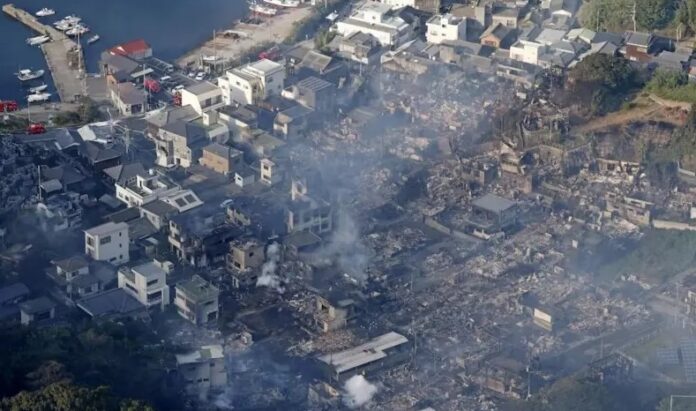Japan Largest Urban Fire: Beginning of a Devastating Blaze
The Japan largest urban fire in decades has stunned the country, leaving residents of Oita in shock as more than 170 buildings were destroyed in a massive blaze that tore through the coastal city. The scale of destruction has raised urgent questions about urban safety, fire preparedness, and climate-driven risks in Japanese towns.
This article takes you through the full timeline, impact, cause investigations, and the response to the Japan largest urban fire, while offering historical context and expert insights. With aerial footage capturing flames across an area the size of seven football fields, the disaster has become one of the most alarming urban incidents Japan has faced in nearly 50 years.
Japan Largest Urban Fire Explained – What Sparked the Crisis?
Authorities say the Japan largest urban fire ignited near a fishing port in Oita. Although the exact cause is still under investigation, officials suspect the blaze may have spread rapidly due to tightly packed wooden homes—common in older Japanese neighborhoods.
Residents reported seeing smoke rising just after midday, and within minutes, strong coastal winds pushed flames from home to home, giving people little time to escape.
Local media confirmed that one person was killed, while many others were forced to flee as evacuation orders swept across the district.
A Closer Look at the Scale of the Japan Largest Urban Fire
The Japan largest urban fire reached a level of destruction not seen since 1976, excluding fires caused by earthquakes. Aerial videos published by NHK and other outlets show flames stretching across several city blocks.
The destruction included:
-
Over 170 residential and commercial buildings
-
Infrastructure damage across several streets
-
Evacuation of hundreds of families
-
Emergency response teams from multiple districts
Firefighters struggled for hours to contain the blaze, which continued spreading due to gusty winds and dry materials in older coastal structures.
How the Japan Largest Urban Fire Compares to Historical Incidents
Japan has a long history of fires, many linked to traditional wooden housing and dense urban layouts. However, the Japan largest urban fire stands apart because:
-
It occurred in a modern city environment
-
It spread across a wide geographical footprint
-
It required multi-prefecture support
-
It highlighted current risks of aging city districts
This disaster mirrors historic events like the 1976 Sakata Fire, which also destroyed over 1,000 buildings. Yet, modern firefighting methods prevented even greater loss in Oita.
Eyewitness Accounts From the Japan Largest Urban Fire
Residents described scenes of chaos as the Japan largest urban fire rapidly engulfed the area.
Some locals said the flames moved “like a wall of fire,” while others were heartbroken watching family businesses and homes disappear. Many praised firefighters for their speed and dedication, calling them “heroes who put themselves in the center of danger.”
One resident told local reporters:
“The fire moved faster than anything I’ve ever seen. We had no time to gather things. We just ran.”
Another resident described seeing ash fall from the sky like snow.
Government Response to the Japan Largest Urban Fire
Japan’s government began coordinating emergency shelters, food supplies, and medical help immediately after the Japan largest urban fire broke out.
The Ministry of Internal Affairs and Communications confirmed that:
-
Support funds will be released for displaced families
-
Damage inspection teams have been deployed
-
Long-term rebuilding support will follow
Oita’s mayor declared the event “a major disaster,” promising to rebuild affected neighborhoods as quickly as possible.
For reference, guidelines on disaster recovery can be found on Japan’s official emergency management page:
https://www.bousai.go.jp/
Why the Japan Largest Urban Fire Spread So Fast
Experts believe several factors contributed to the rapid spread:
1. Dense wooden buildings
Traditional homes burn quickly and create fire bridges.
2. Strong coastal winds
Oita’s port location allowed winds to push flames from house to house.
3. Aging infrastructure
Old electrical wiring may increase fire risk in small districts.
4. Narrow streets
Fire trucks struggled to reach certain blocks quickly.
These factors combined to create the perfect storm for the Japan largest urban fire.

Lessons Learned From the Japan Largest Urban Fire
Urban planners and fire safety officials are already reviewing the disaster to understand how cities can prevent similar events.
Improvements now being discussed:
-
Fire-resistant materials in older neighborhoods
-
Widening access routes
-
More community-level alarm systems
-
Stronger coastal wind monitoring
-
Better evacuation training
Japanese cities regularly update safety guidelines, which can be explored here:
https://www.japan-guide.com/e/e2229.html
Future Outlook After the Japan Largest Urban Fire
Rebuilding after the Japan largest urban fire will take time. Many families must now reconstruct their homes, businesses, and daily lives. The emotional toll may last much longer than the physical damage.
Officials emphasize that preventing another event of this scale is now a national priority.
Japanese citizens, however, are known for resilience. Throughout interviews, people expressed determination to recover and rebuild stronger than before.

